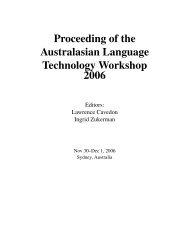The MBC information booklet - RMIT University
The MBC information booklet - RMIT University
The MBC information booklet - RMIT University
Create successful ePaper yourself
Turn your PDF publications into a flip-book with our unique Google optimized e-Paper software.
CHAPTER 9 Software Engineering<br />
9.1 Courses<br />
9.1.1 ISYS2377—<br />
Enterprise<br />
Architecture<br />
9.1.2 ISYS1083—<br />
Object-<br />
Oriented<br />
Software<br />
Design<br />
Chapter 9: Software Engineering<br />
<strong>The</strong> software development industry evolves constantly with innovations in the tools and<br />
methods used in project management, software design, testing, prototyping, metrics and<br />
other aspects of the software development. <strong>The</strong> Software Engineering cluster offered by<br />
this School equips students with a solid foundation in software engineering principles for<br />
continued learning and mastering of new software engineering paradigms and<br />
approaches. Students are prepared for future roles as software developers and testers,<br />
software architects and designers. This cluster also provides technical foundations for IT<br />
management roles.<br />
Pursuant to demand, the following courses are available for students who wish to choose<br />
this cluster:<br />
• ISYS2377—Enterprise Architecture (see page 39)<br />
• ISYS1083—Object-Oriented Software Design (see page 39)<br />
• COSC2275—Software Requirements Engineering (see page 40)<br />
• ISYS1081—Software Reuse (see page 40)<br />
• ISYS1085—Software Testing (see page 40)<br />
• COSC1182—Usability Engineering (see page 41)<br />
• ISYS1088—Systems Architecture (see page 41)<br />
Course Description<br />
This course presents the key components and processes involved in the effective creation<br />
and governance of enterprise architectures. An enterprise architecture is an overall<br />
framework and strategic objective for the usage of technology over time across an<br />
organization; it provides a plan and objectives that align business goals with ICT strategy,<br />
to enable the organization to make the most effective use of ICT to support and build the<br />
business. Students will acquire knowledge about all of these aspects of enterprise<br />
architectures, learn what the choices are and how to make them for enterprise<br />
architectures, and be able to explain and present their decisions.<br />
Pre-requisite Courses and Assumed Knowledge and Capabilities<br />
• Students will be expected to understand the key processes, knowledge and usage of<br />
software requirements engineering acquired in COSC2275 Software Requirements<br />
Engineering. In addition the capabilities being acquired in this course will be<br />
complemented by those acquired in the courses ISYS1088 Systems Architecture<br />
and IT Governance and Change Management.<br />
For more <strong>information</strong> on the course, go to www.rmit.edu.au/courses2006/037926.<br />
Note: This is a Masters-level course.<br />
Course Description<br />
This course aims to investigate, understand and apply the software design process, using<br />
an object-oriented paradigm. <strong>The</strong> course has two major components. It first introduces the<br />
Unified Modelling Language *UML), and a number of software development processes,<br />
including the Rational Unified process. <strong>The</strong> second half of the course is devoted to the<br />
understanding of a catalogue of design patterns, selected from Gamma et.al.<br />
Pre-requisite Courses and Assumed Knowledge and Capabilities<br />
• Two of the following topics must have been studied as part of an undergraduate<br />
Software Engineering or Computer Science course:<br />
• Structured Design<br />
39
















